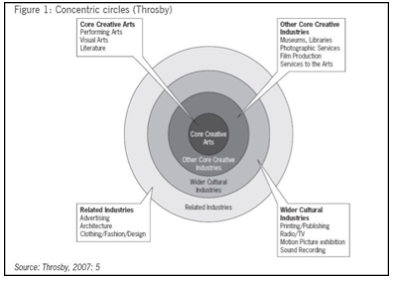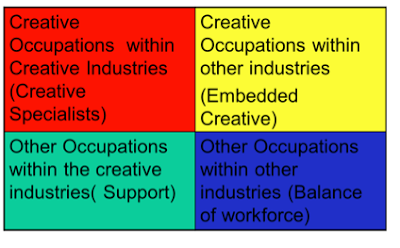In Botswana and elsewhere in Africa there is a high potential for the cultural and creative industries or the creative economy to diversify the economy away from factor dependency, especially through grassroots innovations and vocational skills application.
The cultural and creative industries are “those industries which have their origin in individual creativity, skill and talent and which have a potential for wealth and job creation through the generation and exploitation of intellectual property” (UK Creative Industries Task Force, 2001)
Landry and Bianchi (1995) mentioned that the industries of the twenty-first century will depend increasingly on the generation of knowledge through creativity and innovation.
Howkins (2001) went on to support this by noting and showing how the creative industries have been seen to become increasingly important to economic well-being, proponents suggesting that “human creativity is the ultimate economic resource”.
David Throsby’s (2001) theory on the model of concentric circles is based on the proposition that the cultural value of cultural goods is the distinguishing characteristic of the creative industries. In this model, creative ideas originate in the core creative arts in the form of sound, text and image, and these ideas and influences diffuse outwards through a series of layers or “concentric circles”, as illustrated in Figure 1. This is the home of the artist – the musician, lyricist, dancer, choreographer, composer, writer, painter, sculptor, scriptwriter or designer (Joffe, 2010).
In a recent report prepared for the UK’s Department for Culture, Media and Sport (DCMS), the Work Foundation developed a Stylized Typology of the Concentric Circles model of the creative industries as represented in Figure 2. The stylized typology of the creative industries introduces into the diagram the relationship between the Core creative fields, Cultural industries, Creative industries and the Rest of the economy, as well as the notion of expressive value and outputs, which is unlike the original Concentric Circles Model.
Richard Florida (2012) in his creative economy book “The rise of the creative class revisited” notes that the Creative Age can been distinguished by the rise of two great social classes. The first is the Creative Class, workers in science and technology, arts, culture and entertainment, healthcare, law and management, whose occupations are based on mental or creative labor. The second and larger one is the Service Class, whose members prepare and serve food, carry out routine clerical and administrative tasks, provide home and personal health assistance, do janitorial work, and the like. The Service Class has grown alongside the Creative Class, rising from twenty percent of the workforce in the late nineteenth century and thirty percent in the 1950s to almost half of the workforce, 60 million plus workers, today in the USA.
It is conclusive to note that economic profit is significant across all sectors of society as the money is often used beyond the confides of the owner and the investor. It stimulates growth of the firm and communities it operates in, directly and indirectly through the respective micro and macro level benefits of economic profits.
The overall role of the state and its institutions like LEA, Department of Cooperatives, BOCCIM, and CEDA is to ensure that a harmonious environment is created to maximize the above, but in Botswana these and many more initiatives seem to be failing due to a lack of relevantly educated graduates or human resource base.
So for Botswana to reach the ultimate goal and success in this journey a harmonized multi-sectoral approach pegged with an effective human resource development strategy is required and it will indeed further require a lot of government activism to ensure that perfect knowledge is created and this is realized especially given that the economic growth is starting to decline, yet there is lack of perfect knowledge and a need for skilled expertise to drive the economy forward.
The conclusion statement of the Citizen Economic Empowerment Act and Policy of Botswana as approved on the 8th of August, 2012, purports clearly that a more strategic and holistic approach to citizen economic empowerment is critical if the future growth of the economy of Botswana is to be sustained through private sector expansion or growth. Economic growth and development, and empowerment are interdependent and intertwined.
Empowerment is a powerful catalyst for economic growth and development. On the other hand, rapid economic growth and diversification without meaningful citizen participation could ultimately lead to a more fragile and vulnerable economy. The underlying principle or basis, therefore, for citizen economic empowerment in Botswana, which goes hand-in hand with economic growth and development, is to promote social cohesion and harmony, promote a notion of nationhood and pride, maximize potential of human capital residing in Botswana, and reduce both absolute and relative poverty. These are all qualities that lie in the creative industries as key drivers which have been labelled the priority driver of the Botswana economy in 2013 and beyond.
As will be shown in the next blog post by my co-author Merle O’Brien success lies behind valorizing as shown in the figure below or the value based/human centered approach to development which is similar to the IDIN philosophy.





















